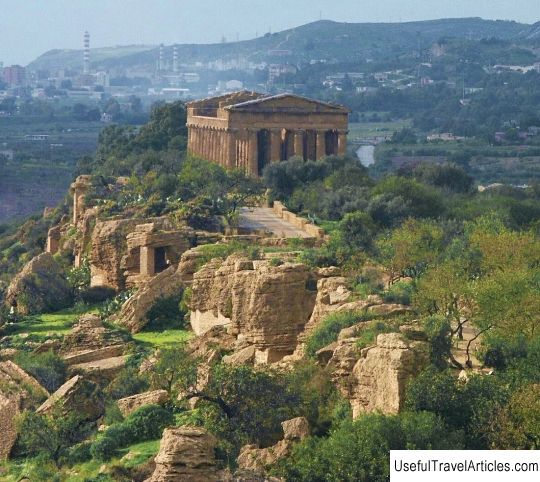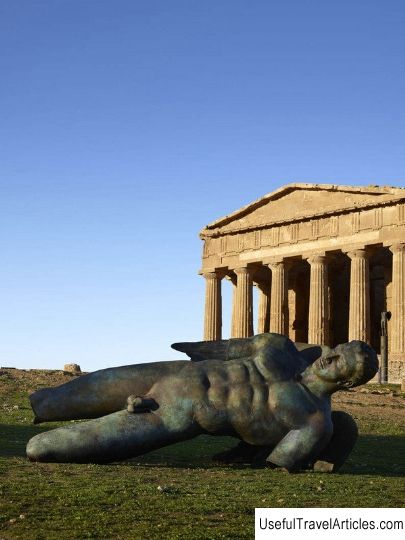Valley of the Temples (Valle dei Templi) description and photos - Italy: Agrigento (Sicily)
Rating: 9,3/10 (1430 votes) 
Valley of the Temples (Valle dei Templi) description and photos - Italy: Agrigento (Sicily). Detailed information about the attraction. Description, photographs and a map showing the nearest significant objects. The title in English is Valle dei Templi. Photo and DescriptionThe Valley of the Temples, located in the area of Agrigento in Sicily, is one of the most outstanding examples of art and architecture of Magna Graecia, and one of the main attractions of the island and a national monument of Italy. In 1997, the territory of the valley was included in the list of UNESCO World Cultural Heritage Sites. I must say that the term "valley" in this case is not used quite correctly, since this place is located on the ridge outside Agrigento. Here are the ruins of seven Doric temples. Most of the excavations in the valley and the further restoration of the temples took place thanks to the efforts of the famous Italian archaeologist Domenico Antonio Lo Fazo Pietrasanta, who from 1809 to 1812 bore the title of Duke of Serradifalco. Besides, here, in the valley, is the so-called Tomb of Theron - a huge pyramidal monument made of tuff and, as it is assumed, dedicated to the memory of the Romans who died during the Second Punic War. The Juno Lachinia Temple was built on an artificial elevation around 450 BC. It measured 38.1 x 16.9 meters and was surrounded by 19 columns. The building was badly damaged in a fire in 406 BC. and was rebuilt in the Roman era. Today only the front colonnade with a part of the architrave and frieze has survived from its former splendor. Burials of the Byzantine period are located nearby. To the north of the Lachinia temple is the so-called Castor and Pollux temple, which was actually built in the 19th century from various parts of other temples. It consists of 4 columns and an entablature, placed on the base of an ancient temple measuring 31 x 13.3 meters. The Temple of Concordia, due to its excellent condition, is considered one of the most significant buildings of the Greek civilization that have survived to this day. It has about the same dimensions as the Lachinia temple and is also surrounded by columns. Outside and inside, its walls were covered with plaster, and the roof was covered with marble tiles. In the Byzantine era, the temple was turned into a Christian church: the pagan altar was destroyed, and a sacristy was built in the eastern corner. The burials around the temple date back to the Middle Ages. The Temple of Asklepius, built at the end of the 5th century BC, stands in the center of the San Gregorio plain. It is much smaller than the previous temples, and historians still doubt its purpose. In the sanctuary of the temple you can see a bronze statue of Apollo by the Greek sculptor Myron - a gift from the Roman commander Publius Cornelius Scipio. The Temple of Hercules was erected at the end of the 6th century BC, and is considered one of the first temples built during times of Theron's reign. True, different parts of the temple are of different ages, which suggests that it was built for a long time or was rebuilt. This is one of the largest temples in the valley - it measures 67 * 25.3 meters and is surrounded by 21 Doric columns. In its eastern part, the remains of a large altar have been preserved. On the other side of the road leading through the Golden Gate of the ancient city, there is a plain with a huge Olympic field, on which stands the Temple of Zeus and several other buildings, which were closed during the excavations. Only ruins remained of the once magnificent temple - the destruction began in ancient times and continued until the 18th century, when the building was used as a quarry for the construction of the town of Port Empedocle. The temple of the Volcano, erected in the 5th century BC, is also located here. Its decorations, created in the years 560-550 BC, have recently been restored.         We also recommend reading Armenian Cathedral of St. Nicholas description and photo - Ukraine: Kamyanets-Podilsky Topic: Valley of the Temples (Valle dei Templi) description and photos - Italy: Agrigento (Sicily). |




